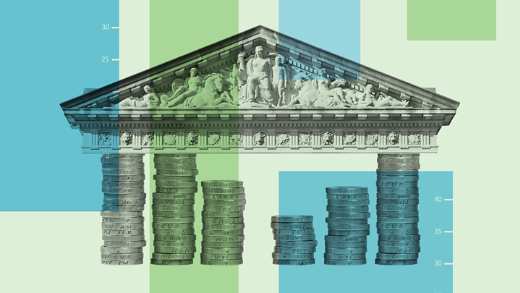Read this article to understand:
- The structural issues facing the Chinese economy
- How the crisis in China’s property sector could weigh on growth
- The potential parallels with Japan’s “lost decades”
The atmosphere in Beijing’s Great Hall of the People was one of hushed reverence. Addressing the Communist Party Congress, China’s president Xi Jinping turned to a matter of grave national importance: fertility. “We will establish a policy system to boost birth rates and pursue a proactive strategy in response to population ageing,” he said.1
Most of the media attention following the Congress in October focused on Xi’s aggressive promotion of loyalists to cement his own position as leader, which spooked markets. More recently, nationwide protests against the government’s zero-COVID policy, which dictates stringent lockdowns to contain coronavirus outbreaks, have made headlines around the world.
But Xi’s reference to birth rates was a sign his government is also grappling with longer-term structural issues, including the country’s unfavourable demographic trends. Just 10.6 million babies were born in China in 2021, the lowest number recorded since the advent of Communist rule in 1949.2 The population is set to go into decline next year, with the proportion of elderly citizens rising fast.3 The demands of an ageing population will put increasing strain on government finances at a time when GDP growth is already slowing.
Year-to-date growth stood at three per cent as of the third quarter, according to official data, lagging the government’s annual target of 5.5 per cent. The World Bank forecasts China’s GDP will slump to 2.8 per cent in 2022, slower than the expected rate for the wider Asia region for the first time in three decades.4
The road to Japanification
The proximate cause of the growth slowdown is Xi’s ongoing zero-COVID policy, which is stoking widespread anger. In late November, a deadly fire at an apartment block in Xinjiang province sparked protests in several cities, after claims strict lockdown procedures had been a factor in the death toll. Some demonstrators clashed with police and chanted slogans critical of Xi himself, in a rare challenge to the leader’s authority.
But China also faces deeper-rooted problems. As well as an ageing population, Beijing is struggling to manage an economic transition away from lavish debt-fuelled investment towards consumer-led growth. And an escalating crisis in the property sector could yet spread contagion into other areas of the economy.
These factors have led some experts to draw comparisons between China and neighbouring Japan. In the early 1990s, the bursting of an asset-price bubble brought Japan’s high-growth era to an abrupt end, inaugurating a period dubbed the “lost decades”. As in China, Japan’s population is ageing quickly, inhibiting government efforts to rouse the economy.
“Although there are differences, it makes sense to worry about the ‘Japanification’ of China,” says David Nowakowski, senior multi-asset and macro strategist at Aviva Investors. “The demographic trends are very similar and there is also a property crisis, as there was in Japan in the 1990s. It is possible China’s high-single-digit growth phase is coming to an end.”
There are worse fates than resembling Japan: an affluent, stable country whose citizens enjoy an enviable quality of life. At this point in time, China is the world’s second-largest economy but much poorer than Japan. Slower, more-sustainable growth in China would also help curb climate change and pollution. Nevertheless, a prolonged Chinese growth slowdown could have a big impact on domestic markets and the global economy. So how likely is Japanification and what kinds of policies are necessary if China is to change course?
Growth “miracles”
To understand the root causes of Japanification, we need to look at the evolution of Japan’s economic model.
Like China, Japan was once a poor, war-ravaged country that transformed itself into an export powerhouse. In 1979, American academic Ezra Vogel published a bestselling book entitled Japan as Number One, in which he argued Japan, then the world’s second-largest economy, would soon overtake the US.
Vogel came close to being proved correct. As the US went into recession in the early 1980s, Japan continued to grow strongly, building up a huge trade surplus based on exports of cars and consumer electronics. In 1988, the financier George Soros predicted a “transfer of economic and financial power from the US to Japan”, anticipating the handwringing over China’s rise 30 years later.5
Speculation on stocks and property inflated asset prices and Tokyo real estate fetched astronomical sums
But Japan’s growth proved unsustainable. In the mid-1980s, prime minister Yasuhiro Nakasone acknowledged the need for Japan to become an “importing superpower”, transitioning away from production and fixed investment towards consumer-led growth.6 Instead, the economy was buoyed on a wave of cheap credit as the financial system was liberalised in the second half of the decade.
Speculation on stocks and property inflated asset prices and Tokyo real estate fetched astronomical sums. Per square foot, prime real estate in the Japanese capital in 1989 was selling for $20,000 per square foot (almost four times as much as the priciest real estate in the world today – even before adjusting for inflation).7
The Bank of Japan belatedly tried to cool overheated markets by hiking interest rates, but land prices kept rising until 1991, when the bubble finally burst. Prolonged stagnation followed. Saddled with bad loans, banks were unable to get capital circulating. Deflation took hold. The Bank of Japan kept interest rates close to zero, sometimes cutting them to negative levels; public debt levels rose because corporates refused to borrow and households insisted on saving.
GDP growth remained disappointing over subsequent years despite extraordinary fiscal and monetary stimulus, notably under former president Shinzo Abe’s “Abenomics” programme. In dollar terms, the Japanese economy remains around the same size in 2022 as it was in 1994.8
Misallocation of resources
Some experts fear the Chinese growth juggernaut is about to hit the buffers in the same way. While there are key differences – China’s per-capita GDP is around $12,000, less than half the $29,000 figure for Japan in 1991 – there are undeniable echoes of Japan’s debt-driven boom. Debt among businesses and households has risen to comparable levels to those seen in Japan before its crash (see Figures 1-3).
Figure 1: Private debt in Japan and China (percentage of GDP)
Source: BIS, November 2022
Figure 2: Private household debt to GDP
Source: BIS, November 2022
Figure 3: Private corporate debt to GDP
Source: BIS, November 2022
After Communist Party chief and “paramount leader” Deng Xiaoping launched market reforms in 1978, China developed quickly via large-scale spending on physical infrastructure over the subsequent decades. This helped modernise and upgrade the productive capacity of the economy while improving living standards. China’s accession to the World Trade Organisation in 2001 integrated it more fully into the global economy, supercharging exports and providing a further boost to GDP growth and incomes.
Around one fifth of all the files in the Party archives since the late 1970s relate to the topic of debt
Debt was always an issue, however. According to China scholar Frank Dikötter, around one fifth of all the files in the Party archives since the late 1970s relate to the topic of debt.9 A rising debt pile was not a problem as long as the economy was growing fast enough to absorb it, but over the last two decades fixed investment has become markedly less effective in spurring growth.
In an essay for the Carnegie Endowment, Michael Pettis, professor of finance at Peking University’s Guanghua School of Management, estimates Chinese investment started becoming less productive at some point between 2006 and 2008. Since then, debt has risen sharply, the growth rate has moderated and exports decreased in importance relative to investment (see Figure 4).
“By 2006-2008, like every other country that has followed a similar high-savings, high-investment growth model – most notoriously the Soviet Union in the 1950s and 1960s, Brazil during those same decades, Japan in the 1970s and 1980s, and perhaps a dozen other countries – China seemed to have closed the gap between its level of capital stock and the level that its workers and businesses could productively absorb, after which China’s debt burden began to rise rapidly,” Pettis wrote.10
Figure 4: Unsustainable investment: Rising debt in China (percentage of GDP) versus slowing growth
Note: Growth figure for 2022 based on World Bank’s full-year forecast.
Source: BIS, World Bank, November 2022
Property crisis: The bubble bursts?
High investment over the last ten years means 25-30 per cent of China’s GDP is now associated with property or related industries, according to data from the Peterson Institute for International Economics.11
China's house price-to-income ratio was above 27, compared with less than ten in the UK and less than five in the US
As real estate demand pushed up prices, huge swathes of the Chinese economy came to expect and depend on ever-higher valuations, even as housing became increasingly unaffordable in major cities. As of October 2021, the house price-to-income ratio in China was above 27, compared with less than ten in the UK and less than five in the US.12
Local governments in China benefited from higher revenues as they sold off parcels of land to developers, in some cases using the proceeds to invest more in infrastructure. As land increased in price, developers were able to borrow more against it as collateral; accessing more funds, often through the shadow banking sector as well as through pre-sales of planned sites, builders used the proceeds to make further speculative purchases.13 By 2020, China’s largest developer, China Evergrande, had amassed enough land to house the entire population of Portugal – and accumulated more than $300 billion in debt. It defaulted on an international debt payment in December 2021.14
Three red lines
Alarmed by leverage in the sector, the government announced “three red lines” to restrict borrowing in August 2020 and house prices have since begun to decline (see Figure 5). This has created problems not just for developers but also local governments, whose revenues have fallen, leaving them less able to service their own debts or that of their local government financing vehicles (LGFVs).
Figure 5: China Real Estate Price Index: residential buildings, secondary market (per cent)
Source: Macrobond, October 2022
While the property bubble resembles Japan’s in some respects, most experts believe a precise repeat of Japan’s 1991 crisis is unlikely. More probable is that the Chinese government will try to enact a gradual and controlled deleveraging process that will weigh on the economy over a prolonged period, potentially with a few accidents and U-turns along the way.
The government will probably continue to extend liquidity to developers to avoid a sharp slowdown
Beijing has already de-emphasised some of its own red lines as it tried to offset the growth impact from the zero-COVID policy and avoid a sharp contraction in GDP during the run-up to the Congress in October. According to media reports, local governments and state-owned enterprises have begun to buy thousands of apartments to bail out indebted private developers.15 On November 14, the central bank and banking regulator announced further relief measures, including an extension to the deadline for lenders on limiting the ratio of loans they provide to the property sector.16
“Given the Chinese authorities’ strong control over the financial system and the corporate sector, China should be able to avoid a Japan-style financial crisis in the short term,” says Amy Kam, senior portfolio manager for emerging market debt at Aviva Investors. “The government will probably continue to extend liquidity to developers to avoid a sharp slowdown as it is concerned about both the financial and political consequences.”
The authorities are worried about how a property crash might affect social stability, at a time when the zero-COVID policy is already causing civil unrest. Many of the most-indebted developers took deposits on housing developments they were unable to finish; recent months have seen large protests and mortgage boycotts among citizens who were left out of pocket.17
Repairing balance sheets
As the private sector deleverages, one possibility is that China could face what Nomura Research Institute economist Richard Koo calls a “balance-sheet recession”, similar to Japan in the late 1990s and Europe after the financial crisis. During such a recession, economic activity declines as companies and households focus on paying off debt.
The question is: how does China work through the deleveraging process from here?
“So far, China has been able to avert a property crisis by effectively supplying liquidity through the right channels,” says Nowakowski. “The question is: how does it work through the deleveraging process from here? Koo’s balance-sheet recession is a useful model for what China is dealing with in the coming months and years. History tells us the affected sector is going to be missing-in-action for a long time and will not be able to contribute much to overall growth.”
China could have a key advantage over Japan in dealing with a balance-sheet recession, though. Koo argued wrangling between different democratic parties in Japan and Europe meant necessary stimulus measures to compensate for the decline in private-sector demand were insufficient and removed too soon, contributing to the economy’s longer-term malaise.18
By contrast, China’s strong centralised government should be able to sustain stimulus while companies and LGFVs undertake the necessary deleveraging. The bigger question is what, if anything, will pick up the slack as a longer-term driver of growth as debt-driven investment wanes.
Domestic demand and demographics
The Chinese government has acknowledged the need to rebalance the economy by promoting a more sustainable growth model based on domestic demand rather than debt. As Xiang Songzuo, former deputy director of the People’s Bank of China (PBoC), the central bank, conceded in 2019: “Basically China’s economy is all built on speculation, and everything is overleveraged.”19
We have changed the thinking that the GDP growth rate is the sole barometer of success
In a long essay published in 2021 in Qiushi, the theoretical journal of the Chinese Communist Party, Xi wrote: “We have changed the thinking that the GDP growth rate is the sole barometer of success…we cannot blindly pursue rapid growth without regard for objective laws and conditions.” He added that China needs to shift the focus to “pursuing genuine rather than inflated GDP growth” by boosting domestic demand. This would require “expanding consumer spending while also upgrading the level of consumption”.20
A less-favourable macroeconomic environment may force China’s government to expedite this planned transition. Global growth is slowing, partly due to the knock-on impacts of Russia’s war in Ukraine, which has hit demand for Chinese exports following a post-COVID boom. New US restrictions on exports of microchips and other high-end electronics to China will also limit the country’s access to vital components.21
Consumer spending
Shifting the economy towards the consumer will not be easy. As a Chinese proverb has it, “The state is rich, the people are poor”; private consumption’s share of GDP has been falling for decades and now stands at 39 per cent, compared with 68 per cent in the US.22 As Pettis points out, a sustained rise in consumption would require citizens to receive a greater share of the country’s output. But despite a stated commitment to “Common Prosperity”, enacting a transfer of wealth and income from local governments and state-owned enterprises to consumers is likely to be politically difficult, even for a leader as powerful as Xi.23
Another way to spur consumption would be to encourage consumers to spend more of their savings: domestic savings account for 45 per cent of GDP, according to World Bank figures, far higher than advanced economies such as the US (18 per cent) or Japan (25 per cent). But there are complicating factors.
One is that wealth in China is often held in property, which means that as house prices fall, consumers may feel compelled to tighten their belts rather than open their wallets. Another is that the uncertainty surrounding zero-COVID lockdowns is weighing on spending (see Figure 6).
Figure 6: China Consumer Confidence Index
Source: Macrobond, October 2022
“It seems consumers are refusing to spend because they are uncertain about the future, with housing no longer the store of value it was and zero-COVID increasing the need for a safety net,” says Moreno Fasolo, Asia equity portfolio manager at Aviva Investors. “Consumer price inflation is 2.1 per cent as of October 2022, among the lowest figures for any country in the world. That suggests people are hoarding cash. The lasting scars the pandemic leaves on the Chinese consumer might increase the risk of Japanification.”
It seems likely the government will take steps to encourage a shift in the composition of savings away from property by reforming the financial sector and deepening the country’s relatively undeveloped equity markets. Coupled with China’s strict capital controls, this could work to direct capital to domestic firms and potentially create new national champions, Fasolo argues (see investment implications).
Demographic trends
In the meantime, the rapid ageing of China’s population could pose a further obstacle to the government’s efforts to rebalance the economy.
A major cause of the current demographic transition was the Party’s One Child Policy (1980-2016), designed to curb China’s population growth by restricting most families to a single child. The oldest cohort of parents captured by the policy are now entering their eighties, the age at which many people require greater care and financial support.24
Increased costs for health and social care will put a drag on government and household budgets
Increased costs for health and social care will put a drag on government and household budgets and could inflict further economic damage. A recent study by the International Monetary Fund (IMF) shows an ageing population tends to lower the natural rate of interest (the interest rate that supports full employment while keeping inflation constant).25
As Japan has found, a lower rate of interest restricts the scope a central bank has to revive the economy during periods of crisis. Some economic studies also associate a falling working-age population with low inflation, or even deflation, as witnessed in Japan over recent decades (although this correlation is debated).26
Despite the current low levels of inflation in China, Nowakowski believes prolonged deflation is unlikely, given the relative strength of the dollar and weakness of the yuan. But a liquidity trap is a real risk, given the lack of domestic demand. The PBoC has cut rates repeatedly since 2019 in a bid to revive flagging growth.27
“You don't have to be at the zero lower bound to have the functional equivalent of a liquidity trap; it does seem like China is heading in that direction,” says Nowakowski.
Structural reforms
An ageing population is not all bad news, however. China’s population is ageing partly because its citizens are healthier and living longer. In fact, Chinese citizens can now expect to live longer than their US counterparts.28
It is also possible a decline in the working-age population may push up wages by boosting the bargaining power of those in the workforce, potentially helping improve consumption (at the cost of making China less competitive as a manufacturing hub).
And China has another key strength in the form of a sophisticated tech industry. Cutting-edge technology tends to spur productivity and could be a boon to China over the longer term, despite US sanctions on the sector and the recent domestic regulatory crackdown29 on some of the larger tech firms.
The digitalisation of the economy gives China a key advantage over less-successful emerging markets that have fallen into a ‘middle-income trap’
“China has had great success in terms of technological development. Chinese companies are leaders in big data and artificial intelligence and have developed world-leading consumer platforms for e-commerce,” says Kam. “This digitalisation of the economy gives China a key advantage over less-successful emerging markets that have fallen into a ‘middle-income trap’, such as those in Latin America.”
The introduction of stricter tech regulation in recent years was part of the Common Prosperity drive to tackle extreme wealth and reduce inequality in the interests of social stability. But there might be a way to tackle these issues while also ameliorating wider economic and demographic difficulties.
Nancy Qian is professor of Managerial Economics and Decision Sciences at Northwestern University’s Kellogg School of Management and founding director of China Econ Lab, a China-focused research organisation. She believes the government has an opportunity to simultaneously address the problems of a shrinking population, economic inequality and slowing growth by reforming the Hukou system, a law restricting the ability of rural workers to move to urban areas.
“China is really comprised of two economies: rural and urban. The ageing population and the need to fund pensions is really an urban problem. Rural areas, which are poorer, have had higher fertility rates and there are no pensions for the elderly,” says Qian.
“The downside of this is the rural areas are still poor and contribute to overall inequality. The upside is that China has a vibrant internal workforce, where productivity can increase a lot in response to straightforward policies. Improving basic health and education, infrastructure, and giving these workers better access to jobs up the value chain in urban areas can all generate significant aggregate growth,” she adds.
Political risk
Whether China faces the worst Japanification scenarios or manages to rebalance the economy towards more sustainable growth will depend largely on its political leadership. This means, more than ever, that its future will depend on Xi Jinping.
Since the 1990s, Chinese presidents have usually served two five-year terms in office. Xi, who took power in 2012, has not only abolished term limits and pursued a third; he has stacked the Politburo with loyalists, upending a tradition of balancing different Party factions within government in the interests of unity.
Some of Xi’s decisions – such as his promotion to the Standing Committee of Li Qiang, the Shanghai Party secretary who has presided over an at-times shambolic series of city-wide lockdowns – have raised questions as to whether his approach favours loyalty over competence. This certainly seems to be the view of international investors, who sold billions worth of Chinese stocks on the first day of trading after the Congress on October 24 (see Figure 7). Markets fell again after the protests in late November.
Figure 7: Chinese stocks slump after Party Congress
Source: Aviva Investors, Eikon. Data as of October 27, 2022
“The political manoeuvrings at the Congress spooked markets,” says Alistair Way, head of equities at Aviva Investors. “Xi concentrated power and side-lined more reformist, market-friendly names from the top tier of leadership, including central bank governor Yi Gang. The outlook for a reopening of the economy is even less clear than it was before the Congress.
“All sectors have been impacted by the political situation to varying degrees. For example, following the sell-off, big Chinese cement producers were around one sixth of the valuation of their counterparts in India. While India’s growth and demographic prospects are slightly more favourable, this doesn’t explain such a huge discrepancy. That shows the impact China’s authoritarian style of government is having on markets.”
Cautionary tales
One of the factors contributing to investor skittishness is that Xi has done away with a tradition of deliberative policymaking at the top of government.
Qian argues deliberation is useful for several reasons. It allows policies to be made while taking into account all the necessary information; it lowers the political stakes, because a deliberative approach makes it less costly to admit mistakes and adjust course; and it allows for a more responsive, decentralised style of government, which is especially important in a country of China’s vast size. Xi’s more autocratic – if not outright dictatorial – approach increases the risk of policy missteps.
China’s government has long looked to Russia as the cautionary tale it most fears
But events may yet persuade Xi to change tack. Rather than a Japan-style economic fate, China’s government has long looked to Russia as the cautionary tale it most fears. In a private speech to the Party in 2013, for example, Xi issued a warning that China could repeat the Soviet Union’s path from fearsome global power to chaos and oligarchy if it wavered in its commitment to Marxist ideology.30
But Xi will also have been watching Russia’s more recent mistakes. Russia’s costly invasion of Ukraine may cause him to think twice about the wisdom of one-man leadership and the perils involved in a possible Chinese attempt to annex Taiwan by force.
“My sense is that the leadership is keenly aware of China’s recent economic challenges and has also been carefully observing the disaster one-man policymaking has caused for Russia. Hopefully, the government will respond to these events by shifting back towards its former style of gradual, cautious and group-based policymaking,” says Qian.
Managing China’s interlinking problems – a property crisis, social discontent over zero-COVID, an unsustainable growth model, an ageing workforce – is likely to prove the greatest challenge of Xi’s reign. The decisions he makes will have ramifications far beyond China’s borders. Like the powerless cadres packing the upper tiers of the Great Hall at the Party Congress, investors will be watching with interest.
Investment implications
While China could yet avoid Japanification over the long term, many experts are revising down their outlooks for Chinese growth. The consensus among economists surveyed by Bloomberg is that growth will remain below five per cent for each year through 2024.31
Given its size, a slowdown in China’s growth rate is of obvious significance to the global economy. According to IMF figures, China in 2021 accounted for 18.6 per cent of global GDP based on purchasing power parity, up from 7.6 per cent in 2001.32 Nowakowski argues the biggest impact of a Chinese slowdown would be felt among its main trade partners in emerging markets, along with a few advanced economies.
“The commodity exporters that have the strongest trade links in emerging markets in Asia are the main ones that might suffer due to falling Chinese demand, but also Korea, Taiwan and Japan –countries that export a lot of value-added machinery to China. Within Europe, Germany is one that stands out, given its close economic ties to the Asian power. Brazil and other ‘soft’ commodity exporters will likely be less affected,” he says.
Nafez Zouk, emerging markets sovereign debt analyst, agrees with that assessment. “China has never strayed too far from investors’ concerns, whether with regards to geopolitics or the domestic economy. The property market slump and the economic hit from zero-COVID policies are still front and centre of discussions on China. That is leading to a debate as to whether it is facing temporary headwinds or whether its challenges are more structural. Many believe Beijing needs a new growth model, given rising levels of debt and decreasing marginal returns from infrastructure investment.
“Add to that a challenging geopolitical backdrop and strains in the relationship with the US, and there is a palpable feeling China will not be able to support global growth as it used to. That has implications for commodity prices, other emerging market countries and Asian currencies,” Zouk adds.
The vulnerabilities in China’s property sector carry obvious risks for investors in its domestic markets.
Kam says while the portfolios she helps oversee are overweight Chinese corporate debt, the holdings are concentrated in a small number of less heavily indebted sectors that are best able to withstand a tougher economic climate: either debt issued by companies with strong fundamentals or by strategically important state-owned enterprises.
Equity investors, too, are concerned about potential spill-overs from the property crisis and the state of corporate balance sheets, along with the ongoing impact of the zero-COVID policy on economic activity. Way says indebted private companies now look a lot riskier than state-owned enterprises with government backing.
Over the longer-term, however, the necessity to promote greater domestic consumption could create opportunities. China is likely to want to incentivise a shift of savings away from property towards financial instruments, which could benefit Chinese financial services firms.
“We could see an enhanced use of equities, insurance, a broadening of pensions and a deepening of capital markets to enable better facilitation of the savings of an ageing population. A multitude of companies could benefit from that.
“Over the longer term, the inevitable move away from infrastructure to consumption-led growth means a lot of the interesting investment ideas in China are going to be domestic consumption or service related. We have already seen consumer electronics companies like Oppo, Xiaomi and Vivo take market share from Samsung and Apple over recent years. Going forward, domestic brands are likely to take greater market share in other sectors, too, such as electric vehicles,” Way adds.


















